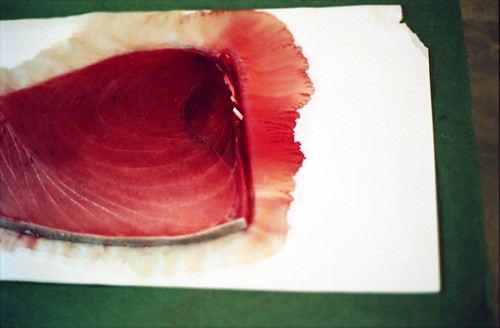Calling all owners of Olympus OM series,
I just ordered my OM2N with Zuiko 50mm/1.4 from Ebay, should be receiving it in 2 weeks time. I bought it for its compactness, lightweight, quietness, fast cheap lens, night photography and awesome bokeh!
But guess i can't wait for the arrival. Am jumping ahead to see what other owners of this fabulous OM cameras + / Zuiko lens in ClubSnap had captured.
Do post your best photos with this wonderful setup or the setup itself here (Zuiko lens on Other bodies also welcome)....and perhaps when the crowd gets bigger, we could organize some "moh-moh" gathering.



image courtesy of Posredstven from Flickr.com

image courtesy of Velco from Flickr.com
---------------------------------------------------------------------
OM Flickr pages -
http://www.flickr.com/groups/olympus-om/
http://www.flickr.com/groups/17099176@N00/
http://www.flickr.com/groups/zuikoincanon/
About the inventor - www.geocities.com/maitani_fan/home.html
OM HISTORY
The three major problems with single-lens reflex cameras were size, weight, and shutter noise /shock. The OM Series solved all of these problems. In 1971, Olympus created a major hit product by packing a powerful system capable of photographing everything from stars to bacteria into the world's lightest and most compact body. The factor that allowed Olympus to eliminate the three problems was the uncompromising determination of everyone involved from design through to production. Considerable effort was applied to the reduction of weight, including the replacement of minute brass screws with steel screws, which were slightly lighter.
The very first model was presented at the Photokina of Köln in 1972 and was called the Olympus M-1. Thirteen years earlier, the release of the Nikon F had made the 35 mm SLR the standard choice for professionals accustomed to Leica and other rangefinders, but it had driven the market towards heavy and bulky cameras. The Olympus M-1 changed this and with it began a reduction of size, weight and noise of the 35 mm SLRs. It was designed by a team led by Yoshihisa Maitani, who had already created the Pen and Pen F cameras, noted for their compactness.
Since Leica's flagship rangefinder cameras are known as the M Series, Leica complained about the name of the M- 1 forcing Olympus to rename it as the OM-1 to further clarify between the brands. Because of this, today bodies and lenses with the original M name are rare (5000 bodies were made according to Olympus) and sought after by collectors.
The OM-1 is an all-mechanical SLR. It has a very large viewfinder with interchangeable screens but a fixed prism. It also has a through-the-lens exposure meter controlling a needle visible in the viewfinder. It has a very compact body, essentially retained on later models.
Originally, the bottom plate needed to be modified to mount a motor drive on the OM-1. In 1974, Olympus launched the OM-1MD (MD standing for Motor Drive), to which a motor drive can be attached without any modification being required. This new version has a small plate marked 'MD' on the front, and a small circular cover with a coin slot (covering the motor drive coupling) on the underside of the body.
The OM-1n is the same as the OM-1MD with a redesigned film advance lever, a flash ready/sufficient flash LED in the viewfinder, and automatic X-sync regardless of the position of the FP/X switch, when it is used with a T-series flash unit mounted on Flash Shoe 4.
OM2 camera went on sale in 1975. It features an automatic exposure (AE) system with an aperture-preferred shutter. The OM-2 also had the world's first TTL direct metering system, which measures light reflected off the surface of the film. This allowed exposure control during shooting, and automatic TTL strobe adjustment using a specially designed strobe. To develop the TTL direct metering technology, Olympus collected 35mm film from throughout the world and measured the reflection ratios for each roll. The results were used to determine the density of printing on the shutter curtain.
The later OM-2N was a slightly improved version. The OM-2S added a spot meter and a new meter display with a white bar graph display instead of the "old fashioned" needle.
OM4 was launched in 1983, the OM-4 was the perfect OM-series camera. It had a light metering system based on up to eight multi-spots. The speed of the electronic shutter was increased to 1/2000 sec. The OM-4 also inherited direct metering technology, and its drip-proofing and durability were improved. An LCD bar-graph was used to display exposure readings in the finder. The result was a product that Olympus could describe with pride as a high-end single-lens reflex camera. The space needed to accommodate the spot-metering mechanism and circuitry was provided by lowering the bottom of the camera. This meant that the motor drive and other features of the OM-1 and OM-2 could also be retained in the OM-4. A later enhanced version, the OM-4Ti, featured a titanium body and enhanced functions.
OM-3 went on sale in 1984. Its mechanical shutter, capable of speeds up to 1/2000 sec. could be operated even without a battery. Olympus enhanced the shutter curtain travel mechanism to ensure reliable high-speed shutter operation at 1/2000 sec. Other improvements included speed control and low-speed shutter systems that were more compact than earlier shutter systems. Like the OM-4, the user could switch between center-weighted and spot light metering with multiple spots. A later enhanced version, the OM-3Ti, featured a titanium body and enhanced functions.
OM-2SP (Spot / Program) was the first OM-Series camera with a programmed exposure control system. It went on sale in 1984. The camera supported programmed control using existing OM system lenses. After selecting the aperture control program on the body, the user could adjust the aperture setting more precisely according to direct light metering. Olympus subsequently introduced exchangeable lenses that were enhanced to provide better performance under programmed aperture control.
Zuiko Lenses!
http://www.datasync.com/~farrar/zuiko.html - Unofficial Olympus OM Zuiko Lens Page
http://www.mir.com.my/rb/photography/hardwares/classics/olympusom1n2/shared/zuiko/index.htm
Awesome lenses include
55mm f/1.2
50mm f/1.4 (MC)
50mm f/1.8
40mm f/2.0
18mm f/3.5
21mm f/2.0
21mm f/3.5
24mm f/2.0
24mm f/2.8
and many more... (check out weblink above)
OM Zuiko Lens adaptor to Other Bodies:
To Oly 4/3 E series - http://www.ephotozine.com/article/Olympus-MF1--OM-Four-Thirds-Adapter-7198
To Canon EOS- http://www.rugift.com/photocameras/olympus_canon-eos-pro_adapter.htm
Other Lens to OM Bodies!
From M42 lens - http://www.rugift.com/photocameras/olympus_om_adapter_with_lens.htm
I just ordered my OM2N with Zuiko 50mm/1.4 from Ebay, should be receiving it in 2 weeks time. I bought it for its compactness, lightweight, quietness, fast cheap lens, night photography and awesome bokeh!
But guess i can't wait for the arrival. Am jumping ahead to see what other owners of this fabulous OM cameras + / Zuiko lens in ClubSnap had captured.
Do post your best photos with this wonderful setup or the setup itself here (Zuiko lens on Other bodies also welcome)....and perhaps when the crowd gets bigger, we could organize some "moh-moh" gathering.

image courtesy of Posredstven from Flickr.com

image courtesy of Velco from Flickr.com
---------------------------------------------------------------------
OM Flickr pages -
http://www.flickr.com/groups/olympus-om/
http://www.flickr.com/groups/17099176@N00/
http://www.flickr.com/groups/zuikoincanon/
About the inventor - www.geocities.com/maitani_fan/home.html
OM HISTORY
The three major problems with single-lens reflex cameras were size, weight, and shutter noise /shock. The OM Series solved all of these problems. In 1971, Olympus created a major hit product by packing a powerful system capable of photographing everything from stars to bacteria into the world's lightest and most compact body. The factor that allowed Olympus to eliminate the three problems was the uncompromising determination of everyone involved from design through to production. Considerable effort was applied to the reduction of weight, including the replacement of minute brass screws with steel screws, which were slightly lighter.
The very first model was presented at the Photokina of Köln in 1972 and was called the Olympus M-1. Thirteen years earlier, the release of the Nikon F had made the 35 mm SLR the standard choice for professionals accustomed to Leica and other rangefinders, but it had driven the market towards heavy and bulky cameras. The Olympus M-1 changed this and with it began a reduction of size, weight and noise of the 35 mm SLRs. It was designed by a team led by Yoshihisa Maitani, who had already created the Pen and Pen F cameras, noted for their compactness.
Since Leica's flagship rangefinder cameras are known as the M Series, Leica complained about the name of the M- 1 forcing Olympus to rename it as the OM-1 to further clarify between the brands. Because of this, today bodies and lenses with the original M name are rare (5000 bodies were made according to Olympus) and sought after by collectors.
The OM-1 is an all-mechanical SLR. It has a very large viewfinder with interchangeable screens but a fixed prism. It also has a through-the-lens exposure meter controlling a needle visible in the viewfinder. It has a very compact body, essentially retained on later models.
Originally, the bottom plate needed to be modified to mount a motor drive on the OM-1. In 1974, Olympus launched the OM-1MD (MD standing for Motor Drive), to which a motor drive can be attached without any modification being required. This new version has a small plate marked 'MD' on the front, and a small circular cover with a coin slot (covering the motor drive coupling) on the underside of the body.
The OM-1n is the same as the OM-1MD with a redesigned film advance lever, a flash ready/sufficient flash LED in the viewfinder, and automatic X-sync regardless of the position of the FP/X switch, when it is used with a T-series flash unit mounted on Flash Shoe 4.
OM2 camera went on sale in 1975. It features an automatic exposure (AE) system with an aperture-preferred shutter. The OM-2 also had the world's first TTL direct metering system, which measures light reflected off the surface of the film. This allowed exposure control during shooting, and automatic TTL strobe adjustment using a specially designed strobe. To develop the TTL direct metering technology, Olympus collected 35mm film from throughout the world and measured the reflection ratios for each roll. The results were used to determine the density of printing on the shutter curtain.
The later OM-2N was a slightly improved version. The OM-2S added a spot meter and a new meter display with a white bar graph display instead of the "old fashioned" needle.
OM4 was launched in 1983, the OM-4 was the perfect OM-series camera. It had a light metering system based on up to eight multi-spots. The speed of the electronic shutter was increased to 1/2000 sec. The OM-4 also inherited direct metering technology, and its drip-proofing and durability were improved. An LCD bar-graph was used to display exposure readings in the finder. The result was a product that Olympus could describe with pride as a high-end single-lens reflex camera. The space needed to accommodate the spot-metering mechanism and circuitry was provided by lowering the bottom of the camera. This meant that the motor drive and other features of the OM-1 and OM-2 could also be retained in the OM-4. A later enhanced version, the OM-4Ti, featured a titanium body and enhanced functions.
OM-3 went on sale in 1984. Its mechanical shutter, capable of speeds up to 1/2000 sec. could be operated even without a battery. Olympus enhanced the shutter curtain travel mechanism to ensure reliable high-speed shutter operation at 1/2000 sec. Other improvements included speed control and low-speed shutter systems that were more compact than earlier shutter systems. Like the OM-4, the user could switch between center-weighted and spot light metering with multiple spots. A later enhanced version, the OM-3Ti, featured a titanium body and enhanced functions.
OM-2SP (Spot / Program) was the first OM-Series camera with a programmed exposure control system. It went on sale in 1984. The camera supported programmed control using existing OM system lenses. After selecting the aperture control program on the body, the user could adjust the aperture setting more precisely according to direct light metering. Olympus subsequently introduced exchangeable lenses that were enhanced to provide better performance under programmed aperture control.
Zuiko Lenses!
http://www.datasync.com/~farrar/zuiko.html - Unofficial Olympus OM Zuiko Lens Page
http://www.mir.com.my/rb/photography/hardwares/classics/olympusom1n2/shared/zuiko/index.htm
Awesome lenses include
55mm f/1.2
50mm f/1.4 (MC)
50mm f/1.8
40mm f/2.0
18mm f/3.5
21mm f/2.0
21mm f/3.5
24mm f/2.0
24mm f/2.8
and many more... (check out weblink above)
OM Zuiko Lens adaptor to Other Bodies:
To Oly 4/3 E series - http://www.ephotozine.com/article/Olympus-MF1--OM-Four-Thirds-Adapter-7198
To Canon EOS- http://www.rugift.com/photocameras/olympus_canon-eos-pro_adapter.htm
Other Lens to OM Bodies!
From M42 lens - http://www.rugift.com/photocameras/olympus_om_adapter_with_lens.htm
Last edited:










